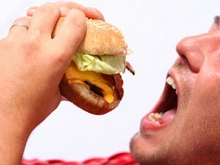
Yet that's lower than it was from 2003 to 2006, when fast food contributed an average of nearly 13 percent of daily calories to the American diet, said report author Cheryl Fryar, of the U.S. Centers for Disease Control and Prevention.
Whether this is an ongoing trend isn't clear, Fryar added. Several factors were examined, to see how they related to how many daily calories U.S. adults got from fast food between 2007 and 2010.
"We could see a difference by age group," Fryar noted. "As you get older, the percentage of calories from fast food declines."
One expert sees this as a positive trend.
"The good news from this study is that as we get older, perhaps we do get wiser and eat less fast food," said Samantha Heller, a clinical nutritionist at the NYU Center for Musculoskeletal Care in New York City.
"However, a take-home message is that the study suggests that the more fast food you eat, the fatter you get," Heller said.
"This is worrisome," she added, "because obesity in one's 20s can increase the risk for metabolic syndrome, diabetes, cancer and cardiovascular disease early in life."
Metabolic syndrome is a group of risk factors -- including high blood pressure, high blood sugar, unhealthy cholesterol levels and abdominal fat -- that increase a person's risk for heart disease and diabetes.
In the national survey, people were asked to recall the source of all the food they'd eaten in the past 24 hours. The response "restaurant fast food/pizza" was coded as "fast food."
Racial/ethnic differences also surfaced in the results.
"Although there was no difference between non-Hispanic white and Hispanic adults, we did find the percent of calories from fast food was higher among non-Hispanic black adults," Fryar noted.
Also, the more a person weighed, the more fast food they consumed as a percentage of their diet, Fryar said.
Highlights of the CDC report include the following:
• From 2007-2010, American adults got 11.3 percent of their daily calories from fast food.
• For those aged 20 to 39, fast food accounted for more than 15 percent of daily calories.
• For those 60 and older, fast food accounted for about 6 percent of daily calories.
• Young adult whites and Hispanics (aged 20 to 39) got about 15 percent of their daily calories from fast food.
• Blacks aged 20 to 39 got about 21 percent of their daily calories from fast food.
• Among weight groups, obese young adults got the most daily calories from fast food -- at 18 percent.
• Income was not a factor in how many daily calories came from fast food, except among those aged 20 to 39, where fast-food calories dropped as income rose.
"Fast food is a fact of life, so we need to find ways we can live with it, not die from it," Heller said. "We need to encourage fast-food establishments to have a variety of healthy offerings that are marketed as cool, sexy, fun and delicious."
And, Heller suggested, "it is important for parents to steer their children away from fast food to begin with. Having more family meals helps kids eat healthier and they are less likely to be overweight."
The findings are published in the February issue of the CDC's National Center for Health Statistics Data Brief.





